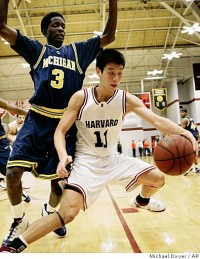“That team could use some black kids!”
This was the comment of Number Two Son, pointing to the mostly white team that his mostly black team beat in an NJB game.
 That incident came to mind when I saw this article about the rarity of Asian-American college basketball players that Efren forwarded. Stereotypical notions about who can play basketball and who can’t already had sunk into Number Two Son. These prejudices affect Jeremy Lin, a starting point guard and leading scorer at Harvard, shown in the picture to the right.
That incident came to mind when I saw this article about the rarity of Asian-American college basketball players that Efren forwarded. Stereotypical notions about who can play basketball and who can’t already had sunk into Number Two Son. These prejudices affect Jeremy Lin, a starting point guard and leading scorer at Harvard, shown in the picture to the right.
The article points out that although basketball is popular with Asian American youth, there are few making it to the college level. “It’s a sport for white and black people. You don’t get respect for being an Asian American basketball player in the U.S.” said Lin. As a Northern California’s Division II player of the year who lead Palo Alto High School to a Division II State Championship, he expected some Division I scholarship offers but gotten exactly none. On the road, he gets taunts like “Go back to China!” and “Open your eyes!”
Stereotypes and blatant racism aren’t the only obstacle that Asian-American athletes face – family attitudes are another. Being in sports aren’t always encouraged, much less having kids aspire to be professional athletes. I have coached mostly Asian-American volleyball teams for a number years, and I have seen all kinds of reasons that Asian-American parents stop their kids from doing sports. These have ranged from “you are too weak to play” and “you might get hurt” to my least favorite one: “you need to concentrate on academics.” I lost a player this year to that last one (a really good one too), and ironically he was already getting good grades! At my sons’ school, kids with grade problems can’t play.
I think some of the problem is with the system of kids’ sports. Adults living vicariously through their kids have professionalized kids sports to the point where if you really want to be competitive in a sport you have to do it all year. In basketball, what usually happens is that in the off-season, the kids are expected to join club teams or compete on AAU teams. In Volleyball, kids are expected to join club teams in the off-season. A high-level traveling volleyball team can be extremely expensive in the range of thousands of dollars. That’s a high cost that I don’t many Asian-American parents wouldn’t pay – they’d have trouble seeing the value in that. I have trouble seeing the value in that myself. In far too many youth sports, the competitive aspect is overemphasized vs the exercise and participation and fun aspects. Kids figure they might as well go play video games if sports is a painful, non-fun experience.
Intermarriage, the article says, will help to produce bigger Asian Americans to counteract the stereotype that Asian Americans are short. I find that the Asian-Americans are generally shorter. When Number One Son sees a taller team (usually mostly white), he usually moans, “Oh no, we’re going to lose.” While my teams have often over come height disadvantages, they have lost to a number of teams because of height.
The article mentions that Asian-American players don’t get respect, but I think that is changing as more and more Asian-Americans get involved in sports. I would say that some of this is from parents who are looking to the future and wanting some kind of sports experience on their kids high school or college applications. I do know a number of kids going the club team route and making it on highly competitive teams. On Number Two Son’s team which is mostly African American, Number Two Son has managed to land the difficult point guard position, earning him respect.
Meanwhile, Jeremy Lin remains a lonely pioneer.
- Excited
- Fascinated
- Amused
- Disgusted
- Sad
- Angry








